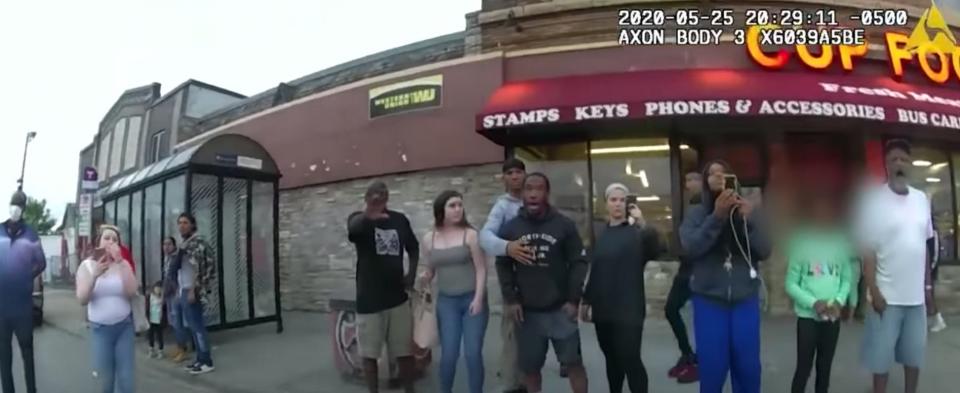Chauvin trial: Why didn’t witnesses help George Floyd? They feared losing their own lives.
Why didn't anyone intervene to save George Floyd's life in Minneapolis? They had more than 9 minutes to do it while he was under Derek Chauvin's knee, but no one did. Some in my diverse group of longtime friends wondered about this recently on Facebook — why no bystander bolted forward to break the chokehold, even knowing they'd be arrested.
What you're missing, I told my friends, is that some of us are Black and some of us are white. Those Black people weren't thinking about being arrested. They are acutely aware that the police will not hesitate to shoot you.
In that place and in that situation, maybe the white onlookers felt the same way. It is traumatic and life threatening to come upon an encounter like the one between Floyd and police officer Chauvin and his subordinates. As they testified in Chauvin’s trial, did you hear the crowd members, young and old, crying on the witness stand because they didn’t save George Floyd? What a regret!
That group of about a dozen was basically made up of an old man, a teenager who I think deserves a medal for recording the whole attack, a couple of little girls, a man who knew martial arts, and some other passersby. Most of them were Black. I think they were brave to do what they did. They did not give up begging and shouting and cussing at Chauvin, who was the highest-ranking officer out there — and Chauvin’s lawyers in court tried to paint them as angry people who distracted police and needed to be controlled.
Invading instead of protecting
I grew up in a Black neighborhood in Cincinnati, where police are known to shoot Black people with impunity, no matter how many demonstrations and occasional riots break out protesting the injustice. Cincinnati.com did a five-month long investigation in 2017 and found that while Cincinnati police had fatally shot 18 people since 2010, no cops had been charged or disciplined for the shootings. Cincinnati is not a majority Black city. Its Black population is 42%.
Police shoot people in Minnesota, too. Remember Philando Castile, 32, shot in front of his girlfriend and her little girl while in his own car reaching for his gun permit? And now there's Daunte Wright, 20, shot to death last Sunday during a traffic stop 10 miles from Minneapolis. The officer who shot him has been charged with second-degree manslaughter.

No way these Minneapolis officers would have hesitated to shoot anyone who got too close. It would have been nice if some hero — Black Panther or Captain America — had come up and intervened, but I am totally afraid that is a fantasy.
Carrying while Black: I'm a licensed gun owner but I haven't carried in years. Why? I'm Black and I'm scared.
Friends suggested that if the other cops had asked Chauvin to change Floyd’s position, perhaps Floyd would still be alive. But one did ask, and Chauvin refused. If only, if only, and behind each one an innocent presumption that police are public servants who certainly wouldn’t kill anyone for no reason. Yet studies of police departments for decades have shown that police act as servants in white neighborhoods where they protect people — but they act like invading forces in Black and Latinx and poor neighborhoods where they must contain the criminal inclinations of the people around them during their shifts, after which many of them return to white neighborhoods.
A close white cop friend once told me that you become a cop because you want to help people, but after a while, to some cops, everyone starts looking like a criminal.
Everything out there for all to see
That day in Minneapolis, there was no being persuasive. The sparse crowd standing obediently on the sidewalk were pleading and some were angry. Everything was happening right out in the open, and Chauvin didn’t seem to care who saw.
Landmark moment: The blue wall of silence crumbles at the Chauvin trial
SUBSCRIBE: Help support quality journalism like this.
There are hints that Chauvin and the people of that neighborhood were not strangers. Chauvin and witness Charles McMillian, 61, had greeted each other just days before the killing. McMillian is the kind of neighbor who lives in most neighborhoods and knows everyone. Before the police put Floyd on the ground, you can hear him in a video, pleading with Floyd not to resist because Floyd wasn’t going to win.
Beyond this encounter, there is Chauvin’s record as a Minneapolis police officer. There were 18 complaints against him in his 19 years there, including six from 2014 through 2019 (one involved a woman) in which he used some sort of force as he did in Floyd’s case. Most of the complaints will not be entered into evidence for this trial, by ruling from the judge.
That "crowd" knew cops are the people with the guns who are likely never to be punished for shooting anyone while on the job.
Starita Smith, Ph.D., is a writer and activist. She was a professor of English and sociology at the University of North Texas and the North Lake Campus of Dallas College. She has also been a reporter and editor at the Gary Post-Tribune, the Columbus Dispatch and the Austin American-Statesman.
You can read diverse opinions from our Board of Contributors and other writers on the Opinion front page, on Twitter @usatodayopinion and in our daily Opinion newsletter. To respond to a column, submit a comment to letters@usatoday.com.
This article originally appeared on USA TODAY: George Floyd witnesses feared they'd die if they tried to stop Chauvin

 Yahoo Movies
Yahoo Movies 
